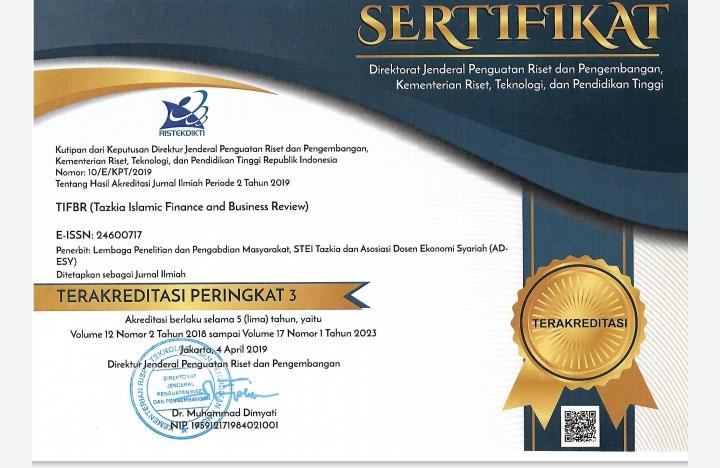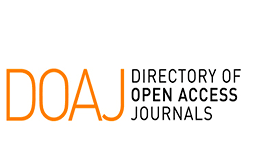COMPARISON OF SHARIA AND CONVENTIONAL BANKING BANKRUPTCY RATES IN INDONESIA
DOI:
https://doi.org/10.30993/tifbr.v13i2.193Keywords:
Islamic Banking, Conventional Banking, CBGB (Commercial Bank – Group of Business), financial performance, Altman Z-ScoreAbstract
The purpose of this study is to determine the position of financial performance, the position of bankruptcy rates of Islamic banking, as well as compare it with conventional banking. This study also compares the accuracy of the bankruptcy predictions of the Islamic banks versus conventional banks using the Altman Z-Score method with the calculation of the financial services authority (OJK). This research will be very useful to provide early warning to Islamic banking in managing the company so that the company management can create some innovations in order to develop the company, avoid bankruptcy. The analysis of this research using some methods. First, the method of Approach Regulation of the Financial Services Authority no. No. 8 / POJK.03 / 2014 which refers to Central Bank of Indonesia regulation no. 9/1 / PBI / 2007 to know the position of financial performance. Second, the Altman Z-Score model to find out the bankruptcy positions of sharia and conventional banking. This study provides the finding of the position of the financial performance level and the position of bankruptcy level of sharia and conventional banking. The conclusion of this research is the performance of sharia banking is not better than conventional banking financial performance, because the position of Islamic banking performance level is ranked 3, while conventional banking is ranked 1. The risk of bankruptcy of sharia bank CBGB 2 is in the position of the gray zone, while conventional banking CBGB 2 is in the safe zone. These results prove that both Altman Z-Score method and the method of Approach Regulation of the Financial Services Authority can provide the same prediction result.References
Altman, E. I., Marco, G., & Varetto, F. (1994). Corporate distress diagnosis: Comparisons using linear discriminant analysis and neural networks (the Italian experience). Journal of banking & finance. Elsevier. 18(3), 505-529.
Altman, E. I. (1977). Predicting performance in the savings and loan association industry. Journal of Monetary Economics, Elsevier. 3(4), 443-466.
Anwar, S., & Hasan, AM. (2016). Early Warning System Untuk Penurunan Kinerja Keuangan Bank Syariah Berbasis Neural Networks. First Gadjah Mada International Conference on Islamic Accounting and Finance. Proceeding. 165-191.
Chieng, Jasmine (2013) Verifying the validity of Altman’s Z” Score as a predictor of bank failures in the case of the Eurozone. Masters thesis, Dublin, National College of Ireland.
Endri. 2009:35. Prediksi Kebangkrutan Bank Unutk Menghadapi Dan Mengelola Perubahan Bisnis: Analisa model Altman's Z-’core. Perbanas quarterly review Journal, Vol. 2. No. 1.
Jan, A., & Marimuthu, M. (2015). Altman model and bankruptcy profile of Islamic banking industry: A comparative analysis on financial performance. International Journal of Business and Management, 10(7), 110. Vol 10, No 7. ISSN 1833-8119.
Kholis, N., & Kurniawati, L. (2016). Analisis Model Prediksi Financial Distress pada Perusahaan Perbankan Syariah di Indonesia. Prosiding Seminar Nasional dan The 3rd Call For Syariah Paper. UMS.
Kusumo, W. K. (2002:2). Analisis rasio-rasio kuangan sebagai indikator dalam memprediksi potensi kebangkrutan perbankan Indonesia. Thesis S2, Program Pasca Sarjana, UNDIP.
Kyriazopoulos Georgios, M. Κ. (2014). The Edward I. Altman’s Model of Bankruptcy and the implementation of it on the Greek cooperative banks. 9th Annual MIBES International Conference, 423-436.
Mamo, A. Q. (2011). Applicability of Altman (1968) model in predicting financial distress of commercial banks in Kenya. PhD diss.
Mukhlisin, M, 2017. “Bank Syariah mau maju pesat, jawabannya kaffah”. Republika.
Peraturan Bank Indonesia, “Sistem Penilaian Tingkat Kesehatan Bank Umum”, No. 6/10/PBI/2004.
POJK no. 21/POJK.03/2014. www.ojk.go.id. Diakses 18 juli 2019.
Prihadi, P. 2008. Deteksi Cepat Kondisi Keuangan : 7 Analisis Rasio Keuangan. Cetakan 1. Jakarta: PPM.
SEOJK 10/SEOJK.03/2014. www.ojk.go.id. Diakses 18 juli 2019.
SNAPSHOT OJK, 2018. Snapshot Perbankan Syariah 2018. www.ojk.go.id. Diakses 16 Juli 2019.
ROADMAP OJK, 2017-2019, Pengembangan Keuangan Syariah Indonesia. www.ojk.go.id. Diakses 15 Juli 2019.
SPS, 2019. Statistik perbankan Syariah 2019. www.OJK.go.id. Dikases 18 juli 2019.
Altman, E. I. (1977). Predicting performance in the savings and loan association industry. Journal of Monetary Economics, Elsevier. 3(4), 443-466.
Anwar, S., & Hasan, AM. (2016). Early Warning System Untuk Penurunan Kinerja Keuangan Bank Syariah Berbasis Neural Networks. First Gadjah Mada International Conference on Islamic Accounting and Finance. Proceeding. 165-191.
Chieng, Jasmine (2013) Verifying the validity of Altman’s Z” Score as a predictor of bank failures in the case of the Eurozone. Masters thesis, Dublin, National College of Ireland.
Endri. 2009:35. Prediksi Kebangkrutan Bank Unutk Menghadapi Dan Mengelola Perubahan Bisnis: Analisa model Altman's Z-’core. Perbanas quarterly review Journal, Vol. 2. No. 1.
Jan, A., & Marimuthu, M. (2015). Altman model and bankruptcy profile of Islamic banking industry: A comparative analysis on financial performance. International Journal of Business and Management, 10(7), 110. Vol 10, No 7. ISSN 1833-8119.
Kholis, N., & Kurniawati, L. (2016). Analisis Model Prediksi Financial Distress pada Perusahaan Perbankan Syariah di Indonesia. Prosiding Seminar Nasional dan The 3rd Call For Syariah Paper. UMS.
Kusumo, W. K. (2002:2). Analisis rasio-rasio kuangan sebagai indikator dalam memprediksi potensi kebangkrutan perbankan Indonesia. Thesis S2, Program Pasca Sarjana, UNDIP.
Kyriazopoulos Georgios, M. Κ. (2014). The Edward I. Altman’s Model of Bankruptcy and the implementation of it on the Greek cooperative banks. 9th Annual MIBES International Conference, 423-436.
Mamo, A. Q. (2011). Applicability of Altman (1968) model in predicting financial distress of commercial banks in Kenya. PhD diss.
Mukhlisin, M, 2017. “Bank Syariah mau maju pesat, jawabannya kaffah”. Republika.
Peraturan Bank Indonesia, “Sistem Penilaian Tingkat Kesehatan Bank Umum”, No. 6/10/PBI/2004.
POJK no. 21/POJK.03/2014. www.ojk.go.id. Diakses 18 juli 2019.
Prihadi, P. 2008. Deteksi Cepat Kondisi Keuangan : 7 Analisis Rasio Keuangan. Cetakan 1. Jakarta: PPM.
SEOJK 10/SEOJK.03/2014. www.ojk.go.id. Diakses 18 juli 2019.
SNAPSHOT OJK, 2018. Snapshot Perbankan Syariah 2018. www.ojk.go.id. Diakses 16 Juli 2019.
ROADMAP OJK, 2017-2019, Pengembangan Keuangan Syariah Indonesia. www.ojk.go.id. Diakses 15 Juli 2019.
SPS, 2019. Statistik perbankan Syariah 2019. www.OJK.go.id. Dikases 18 juli 2019.
Downloads
Published
2020-06-08
How to Cite
Fakhri, U. N., Anwar, S., Ismal, R., & ., A. (2020). COMPARISON OF SHARIA AND CONVENTIONAL BANKING BANKRUPTCY RATES IN INDONESIA. Tazkia Islamic Finance and Business Review, 13(2). https://doi.org/10.30993/tifbr.v13i2.193
Issue
Section
Articles
License

Tazkia Islamic Finance and Business Review (TIFBR) is licensed under a Creative Commons Attribution-NonCommercial 4.0 International License.
Authors who publish with this journal agree to the following terms:
- Authors retain copyright and grant the journal right of first publication with the work simultaneously licensed under a Creative Commons Attribution License that allows others to share the work with an acknowledgment of the work's authorship and initial publication in this journal.
- Authors are able to enter into separate, additional contractual arrangements for the non-exclusive distribution of the journal's published version of the work (e.g., post it to an institutional repository or publish it in a book), with an acknowledgment of its initial publication in this journal.
- Authors are permitted and encouraged to post their work online (e.g., in institutional repositories or on their website), as it can lead to productive exchanges, as well as earlier and greater citation of published work (See the Effect of Open Access).
















